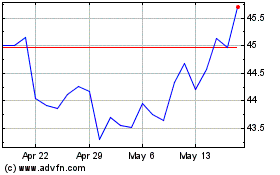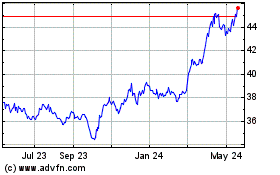Should You Buy Gold Now? - Real Time Insight
June 06 2012 - 10:13AM
Zacks
Gold price reached its one month high this morning, supported by
hopes for additional stimulus by the Federal Reserve, after last
Friday’s weak employment report. The precious metal is now up about
4% year-to-date, after a weak price performance for the last four
months.
According to the World Gold Council, the worldwide demand for
gold was down about 5% during Q1 2012 compared with Q1 2011, mainly
due to import duty in India and higher gold prices.
Demand for the yellow metal in China was up 10% as the country
is now emerging as the largest consumer of gold, leaving India
behind.
In India, the demand for gold fell during the quarter (jewelry
demand down 19% and Investment demand down 46%) due to
imposition of import duty by the government as well as increase in
the price of gold (resulting from sharp decline in the currency).
Gold price in India is now at its all-time high (in rupee
terms).
During the first quarter, the central banks continued to add to
their gold holdings, in order to diversify their reserves. Further,
per data released by IMF, central banks’ gold purchases continued
in April as well. Russia, Mexico, Kazakhstan, Turkey and
Philippines have been the main purchasers this year.
Further, China’s import of gold from Hongkong this year is at
record high levels, leading to speculation that mainland China is
adding to its gold reserves.
There was an interesting article in WSJ a couple days back,
which analyzed gold’s ability to act as “safe haven” using the
short-term correlations with the stock market and bonds.
The article inferred that gold acts as safe haven “when it wants
to be”. Like while it rose two years back over fears over Greece
whereas in the last few weeks, it has moved opposite to the “safe”
bonds which jumped as fears over “Grexit” intensified.
In my view, short-term correlations tend to be volatile since
the investment case for gold does not rest solely on its “safe
haven” status, but many investors especially in India and China
invest in gold due to “store of value” status.
Earlier this year, in addition to the reduced demand from India
(India and China together account for more than 40% of the global
demand), strength in the US dollar also affected the gold
price.
Several studies have shown that over the longer term gold has
the ability to hedge against inflation as also remain uncorrelated
with the stock market returns.
So, there is a strong possibility that the ounce of physical
gold that you buy now (or buy shares in gold ETFs like GLD or IAU)
will preserve its purchasing power in the long-run, whereas other
safe assets like bonds will decline in value in real terms.
Gold has been rising now for the last 11 years in a row and some
analysts say that it may now be heading for its 12th
year of annual gains. And, there are others who think that the
gold’s 11 year bull-run may be over now.
What do you think?
SPDR-GOLD TRUST (GLD): ETF Research Reports
ISHARS-GOLD TR (IAU): ETF Research Reports
To read this article on Zacks.com click here.
Zacks Investment Research
iShares Gold (AMEX:IAU)
Historical Stock Chart
From Jun 2024 to Jul 2024

iShares Gold (AMEX:IAU)
Historical Stock Chart
From Jul 2023 to Jul 2024
